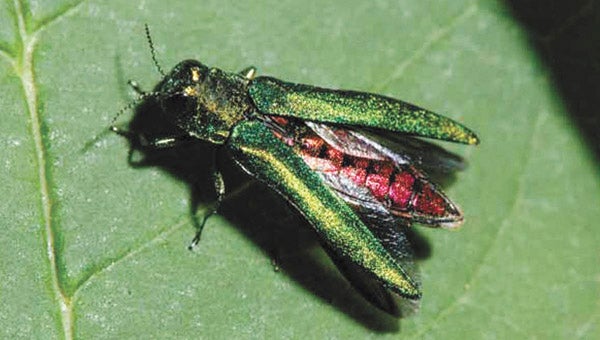Emerald ash borer confirmed in Freeborn County
Published 1:23 pm Wednesday, July 21, 2021

- Emerald ash borer
|
Getting your Trinity Audio player ready...
|
Department of Agriculture to enact emergency quarantine to limit movement of firewood
The Minnesota Department of Agriculture has confirmed emerald ash borer in Freeborn County for the first time.
According to the Agriculture Department, a contractor for a local electric cooperative was doing tree maintenance along utility lines near the city of Alden when they noticed ash trees with signs of emerald ash borer. The contractor contacted the department through the department’s Arrest the Pest line, and MDA staff were able to find live ash borer larvae and collect samples for federal identification.
Emerald ash borer larvae kill ash trees by tunneling under the bark and feeding on the part of the tree that moves nutrients up and down the trunk. Often, the trees show several signs of infestation because of this.
Woodpeckers like to feed on emerald ash borer larvae and woodpecker holes may indicate the presence of the borer. EAB tunneling can also cause the bark to split open, revealing characteristic S-shaped galleries underneath.
Because this is the first time the borer has been identified in Freeborn County, the Minnesota Department of Agriculture is enacting an emergency quarantine to limit the movement of firewood and ash material out of the county. The Agriculture Department issues quarantines for all counties known to have EAB to reduce the risk of further spreading the tree-killing insect.
Joe Grossman, superintendent with the Albert Lea Parks Department, said tree crews have been aware of the ash borer for many years, and to be proactive and diversify the community forest, the city hasn’t planted ash trees for many years. The city has also taken down many ash trees to be proactive.
Grossman said now that the ash borer is so close to the city, the city will have to start treating the city’s ash trees next year with an insecticide trunk treatment, starting with the most valuable trees. It will treat 20% of the ash trees each year for the next three years, giving staff time to get caught up on removals. At that point, they will decide whether to start over with the treatment or to move ahead with more removals.
He referenced many ash trees on Lakeview Boulevard that the city has planted other types of trees next to in the last 15 or 20 years in anticipation that the ash trees might someday have to be removed.
He said the city will come up with a written plan to address not only the city’s trees, but the private trees, as well. He said there are still a lot of ash trees in Albert Lea, most of which are on private property.
“There’s going to be a big issue of ash trees dying on private property, and then the city will have to address those in some way,” Grossman said.
He noted many of the ash trees in the city were planted in the 1980s when Dutch elm disease came through.
He credited Minnesota in being proactive in trying to control the spread, while there are several other states that have not done so. As a result, Minnesota is in a lot better shape than these other states, he said.
Two virtual open houses for residents and tree care professionals in the county will be held on Wednesday, Aug. 11. Experts from the Agriculture Department will give a brief presentation followed by a question-and-answer session.
The public will also have an opportunity to provide input on the proposal to add Freeborn County to the state formal quarantine. The MDA is taking comments on the proposed formal quarantine now through Sept. 3 and recommends adopting the quarantine on Sept. 8. The quarantine limits the movement of ash trees and limbs and hardwood firewood out of the county. The proposed quarantine language can be found at www.mda.state.mn.us/eab.
Comments can be made during the virtual meeting or by contacting: Kimberly Thielen Cremers, Minnesota Department of Agriculture, 625 Robert St. North St. Paul, MN 55155 or kimberly.tcremers@state.mn.us.
The emerald ash borer was first discovered in Minnesota in 2009. It is now in 28 counties.



